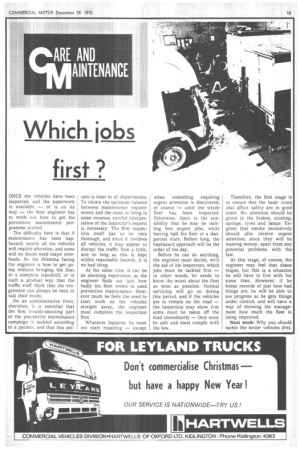Which jobs first
Page 15

If you've noticed an error in this article please click here to report it so we can fix it.
ONCE the vehicles have been inspected, and the paperwork is available — or is on its way — the fleet engineer has to work out how to get his preventive maintenance programme started.
The difficulty here is that if maintenance has been haphazard, nearly all the vehicles will require attention, and some will no doubt need major overhauls. So the dilemma facing the engineer is how to get going without bringing the fleet to a complete standstill, or in such a gradual way that the traffic staff think that the ?Togramme can always he bent to suit their needs.
On an administrative front, therefore, it is essential that the first trouble-shooting part of the preventive maintenance campaign is tackled according to a pattern, and that this pat tern is clear to all departments. To obtain the optimum balance between maintenance requirements and the need to bring in some revenue, careful interpretation of the inspector's reports is necessary. The first inspection itself has to be very thorough, and since it involves all vehicles, it may appear to disrupt the traffic flow a little, and so long as this is kept within reasonable bounds, it is no bad thing.
At the same time, it can be an alarming experience, as the engineer finds out just how badly his fleet seems to need preventive maintenance. However much he feels the need to start work on the vehicles straight away, the engineer must complete the inspection first.
Whatever happens, he must not start repairing — except when something requiring urgent attention is discovered, of course until the whole fleet has been inspected. Otherwise, there is the possibility that he may be tackling less urgent jobs, while leaving half his fleet in a dangerous state. Before long, the haphazard approach will be the order of the day.
Before he can do anything, the engineer must decide, with the aid of his inspectors, which jobs must be tackled first — in other words, he needs to know the worst about the fleet as soon as possible. Normal servicing will go on during this period, and if the vehicles are to remain on the road — the inspection may show that some must be taken off the road immediately — they must be safe and must comply with the law. Therefore, the first stage is to ensure that the basic items that affect safety are in good order. So, attention should be given to the brakes, steering, springs, tyres and lamps. Engines that smoke excessively should also receive urgent attention, since they will be wasting money, apart from any potential problems with the law.
At this stage, of course, the engineer may feel that chaos reigns, but this is a situation, he will have to live with for some time. However, if he keeps records of just how bad things are, he will be able to see progress as he gets things under control, and will have a way of showing the management how much the fleet is being improved.
Next week: Why you should tackle the better vehicles first.




















































